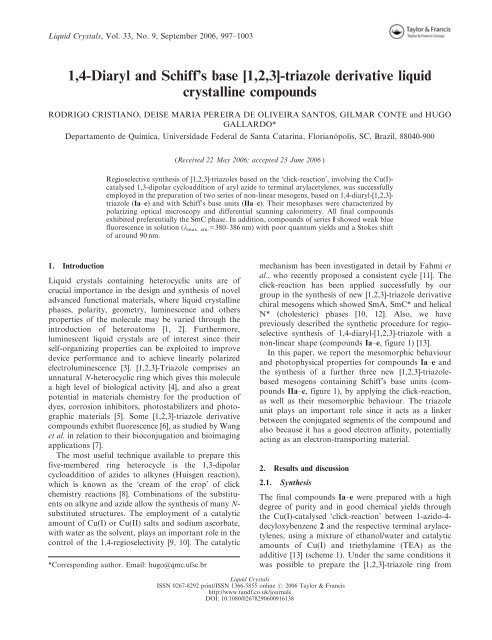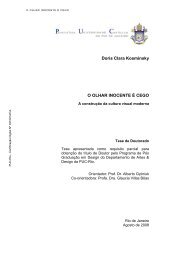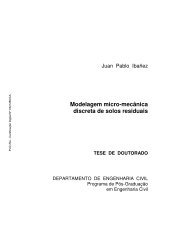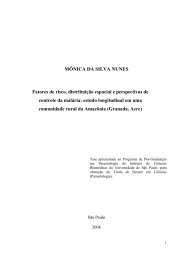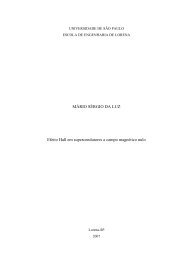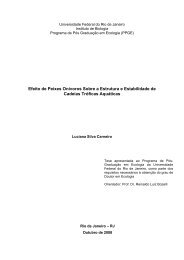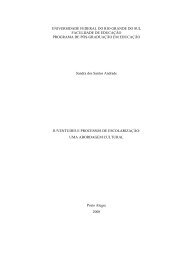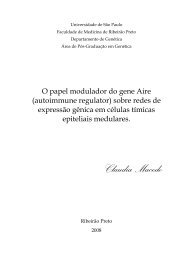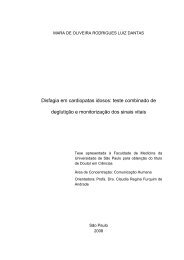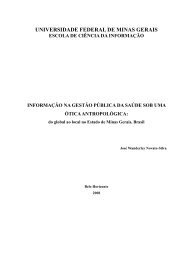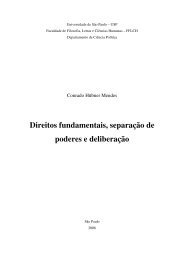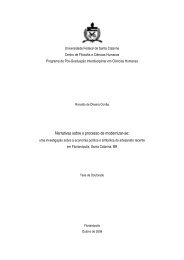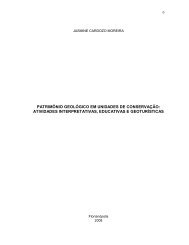Materiais moleculares funcionais contendo n-heterociclos - capes
Materiais moleculares funcionais contendo n-heterociclos - capes
Materiais moleculares funcionais contendo n-heterociclos - capes
Create successful ePaper yourself
Turn your PDF publications into a flip-book with our unique Google optimized e-Paper software.
Liquid Crystals, Vol. 33, No. 9, September 2006, 997–10031,4-Diaryl and Schiff’s base [1,2,3]-triazole derivative liquidcrystalline compoundsRODRIGO CRISTIANO, DEISE MARIA PEREIRA DE OLIVEIRA SANTOS, GILMAR CONTE and HUGOGALLARDO*Departamento de Química, Universidade Federal de Santa Catarina, Florianópolis, SC, Brazil, 88040-900(Received 22 May 2006; accepted 23 June 2006 )Regioselective synthesis of [1,2,3]-triazoles based on the ‘click-reaction’, involving the Cu(I)-catalysed 1,3-dipolar cycloaddition of aryl azide to terminal arylacetylenes, was successfullyemployed in the preparation of two series of non-linear mesogens, based on 1,4-diaryl-[1,2,3]-triazole (Ia–e) and with Schiff’s base units (IIa–c). Their mesophases were characterized bypolarizing optical microscopy and differential scanning calorimetry. All final compoundsexhibited preferentially the SmC phase. In addition, compounds of series I showed weak bluefluorescence in solution (l max. em. 5380–386 nm) with poor quantum yields and a Stokes shiftof around 90 nm.1. IntroductionLiquid crystals containing heterocyclic units are ofcrucial importance in the design and synthesis of noveladvanced functional materials, where liquid crystallinephases, polarity, geometry, luminescence and othersproperties of the molecule may be varied through theintroduction of heteroatoms [1, 2]. Furthermore,luminescent liquid crystals are of interest since theirself-organizing properties can be exploited to improvedevice performance and to achieve linearly polarizedelectroluminescence [3]. [1,2,3]-Triazole comprises anunnatural N-heterocyclic ring which gives this moleculea high level of biological activity [4], and also a greatpotential in materials chemistry for the production ofdyes, corrosion inhibitors, photostabilizers and photographicmaterials [5]. Some [1,2,3]-triazole derivativecompounds exhibit fluorescence [6], as studied by Wanget al. in relation to their bioconjugation and bioimagingapplications [7].The most useful technique available to prepare thisfive-membered ring heterocycle is the 1,3-dipolarcycloaddition of azides to alkynes (Huisgen reaction),which is known as the ‘cream of the crop’ of clickchemistry reactions [8]. Combinations of the substituentson alkyne and azide allow the synthesis of many N-substituted structures. The employment of a catalyticamount of Cu(I) or Cu(II) salts and sodium ascorbate,with water as the solvent, plays an important role in thecontrol of the 1,4-regioselectivity [9, 10]. The catalytic*Corresponding author. Email: hugo@qmc.ufsc.brmechanism has been investigated in detail by Fahmi etal., who recently proposed a consistent cycle [11]. Theclick-reaction has been applied successfully by ourgroup in the synthesis of new [1,2,3]-triazole derivativechiral mesogens which showed SmA, SmC* and helicalN* (cholesteric) phases [10, 12]. Also, we havepreviously described the synthetic procedure for regioselectivesynthesis of 1,4-diaryl-[1,2,3]-triazole with anon-linear shape (compounds Ia–e, figure 1) [13].In this paper, we report the mesomorphic behaviourand photophysical properties for compounds Ia–e andthe synthesis of a further three new [1,2,3]-triazolebasedmesogens containing Schiff’s base units (compoundsIIa–c, figure 1), by applying the click-reaction,as well as their mesomorphic behaviour. The triazoleunit plays an important role since it acts as a linkerbetween the conjugated segments of the compound andalso because it has a good electron affinity, potentiallyacting as an electron-transporting material.2. Results and discussion2.1. SynthesisThe final compounds Ia–e were prepared with a highdegree of purity and in good chemical yields throughthe Cu(I)-catalysed ‘click-reaction’ between 1-azido-4-decyloxybenzene 2 and the respective terminal arylacetylenes,using a mixture of ethanol/water and catalyticamounts of Cu(I) and triethylamine (TEA) as theadditive [13] (scheme 1). Under the same conditions itwas possible to prepare the [1,2,3]-triazole ring fromLiquid CrystalsISSN 0267-8292 print/ISSN 1366-5855 online # 2006 Taylor & Francishttp://www.tandf.co.uk/journalsDOI: 10.1080/02678290600916138


